FLORIDA OR CAPE TOWN
We Locate in Homestead, Florida
Coming into the airport at Miami at 6:00am is not the most delightful
experience in the world. The plane had stopped every two to three
hours at the various airports up the west coast of South America, and
we got very little sleep. I had about $4,000 in travelers checks, so
expected no trouble in renting a car, but the girls on duty at Avis
and Hertz wanted a credit card or nothing. None of the other agencies
were open, but I expect the same requirement would apply. The only
other possibility to get a car that I could think of was to walk out
of the airport to some of the surrounding hotels. The third one had
cars for rent and would take my travelers checks in deposit. It was a
brand new Ford something-or-other, but a sadder new car I had never
seen! I picked up Mary Charlotte and we headed for Homestead. The
more I drove that car the less I liked it. When we passed a large
Toyota agency I suggested stopping to see if they had a used car we
could buy. My car mechanic friend in Cape Town had told me that the
Toyota was by far the best car on the market for the money. They had
a little station wagon with 30,000 or so miles on it and three years
old for $3300. It was a deal! The matter of insurance came up, and I
took the agency recommendation for a well-known company. The
insurance agent came right over. What was my address? I didn’t
have any, not even a motel! We had a friend in Cape Town, Mike d’Udy,
who had told us of his friend in Homestead, Page-Blair. I called
their house and talked to the Mrs. and told her my problem. She had
no objection to our using her address. So we got the insurance. I
persuaded the salesman to drive the new car to the car rental place
so I could turn in the car I had, and I would treat him to lunch.
Finally we reached Homestead and selected a motel in the south end of
town that had efficiencies and moved in. That evening I called Mary
Jo and gave her our location. She gave me Margaret’s phone
number, and I called her, only to learn that Bob had just died! Could
I come to the funeral? Mary Charlotte wouldn’t think of my
leaving her, and I didn’t have money enough left for air fare
for the two of us, so I had to beg off. I have hoped Margaret didn’t
hold it against me. The next few days were spent in looking for a
place to buy. We could count on $45,000, being the $21,000 I had
gotten from Fuller when they sold the Burnett Avenue (Van Nuys, CA)
property while we were in South Africa, and the $24,000 in pensions I
had saved. We soon found that there was practically nothing in that
price range, but in the Sunday ads we saw what looked like what we
might want — "in the forties.’ This was what was
left of a farm with a house built in 1915 that was in fair condition
but full of termites, a tenant farm house nearby that was falling
apart, and 2-2/3 acres of ground, half of which was loaded with fruit
trees (mostly mangoes). Mary Charlotte wanted it, and we had the
money. There was one catch. The owner’s son-in-law lived there
and had to be given time to relocate — like three months. We
signed the papers and made our deposit, and now were free to head for
Anderson and Will’s family. Will loaned us his van to move our
stored stuff to Florida, and it really filled it up!
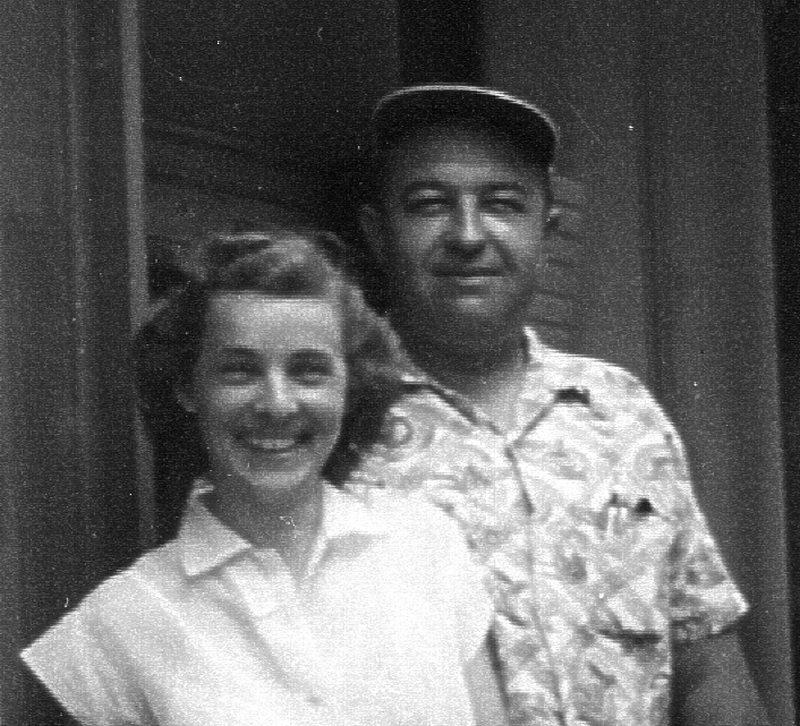 So
right after Christmas we took off for Homestead, stopping in
Birmingham, where Mary Jo and Clyde now lived, to spend a few days.
The morning we were to leave was bitterly cold and the van wou1dn‘t
start. A new battery from Sears fixed that, and we were off, getting
to Homestead late that day. We had rented a duplex in the not-so-good
part of town, which had a number of Mexican migrant laborers living
in the other unit. they helped me unload the van into one of the
rooms. Again the van wouldn’t start, and we had left the Toyota
with Will. I walked all over town (about eight miles), buying a
bicycle that I had to wait until the next day to have assembled,
starting a bank account and buying groceries. One of the Mexicans was
a back-yard mechanic and he said the points were bad. I mounted my
bicycle and bought new points, which he installed. That did it! We
lost no time in returning to Anderson to retrieve our Toyota and come
back to our new home.
So
right after Christmas we took off for Homestead, stopping in
Birmingham, where Mary Jo and Clyde now lived, to spend a few days.
The morning we were to leave was bitterly cold and the van wou1dn‘t
start. A new battery from Sears fixed that, and we were off, getting
to Homestead late that day. We had rented a duplex in the not-so-good
part of town, which had a number of Mexican migrant laborers living
in the other unit. they helped me unload the van into one of the
rooms. Again the van wouldn’t start, and we had left the Toyota
with Will. I walked all over town (about eight miles), buying a
bicycle that I had to wait until the next day to have assembled,
starting a bank account and buying groceries. One of the Mexicans was
a back-yard mechanic and he said the points were bad. I mounted my
bicycle and bought new points, which he installed. That did it! We
lost no time in returning to Anderson to retrieve our Toyota and come
back to our new home.
We had the migrants help us move to the
farm house at 1640 Mowry Drive as soon as we closed. They also helped
us with the crates we had shipped from South Africa the preceding
August, which were waiting for us when we arrived. We had both houses
tented to kill the termites. The next two years were devoted to
renovating both houses, I did all the work myself, buying the
materials at local supply houses and getting their instructions to
install them. I practically rebuilt the interior of the tenant house,
putting in a new plumbing system, water system, electrical system,
two complete bath rooms, hanging new doors, tiling all the floors and
shingling the outside walls with asbestos shingles. It became a very
attractive guest house, with accommodation for a maximum of six
without crowding. In the main house I installed a new plumbing
system, water system, electrical system, completely rebuilt the
bathroom and modernized the kitchen. Ihe only areas that had been in
good condition were the roofs of the two houses, which I didn’t
have to touch. During the two years, I invested $20,000 in materials
and tools, and provided at least 300 days of my labor. We had a few
disagreements about what should be done. Mary Charlotte wanted the
main house to be enlarged. I was willing to incorporate the large
rear porch into the house plan, but she wanted me to widen the whole
house five feet. This I told her was completely beyond my
capabilities, and would likely be beyond anyone’s, as the house
was old, and you just don’t go around moving outside walls.
That argument caused me to wait over a year to do anything to the
main house, as I didn’t want to do anything she was not in
agreement with. Meanwhile, she tried to have a garden, organic style
— no chemicals — and the bugs ate everything she grew.
She had great plans for a fish farm, but the ground was simply not
suitable.
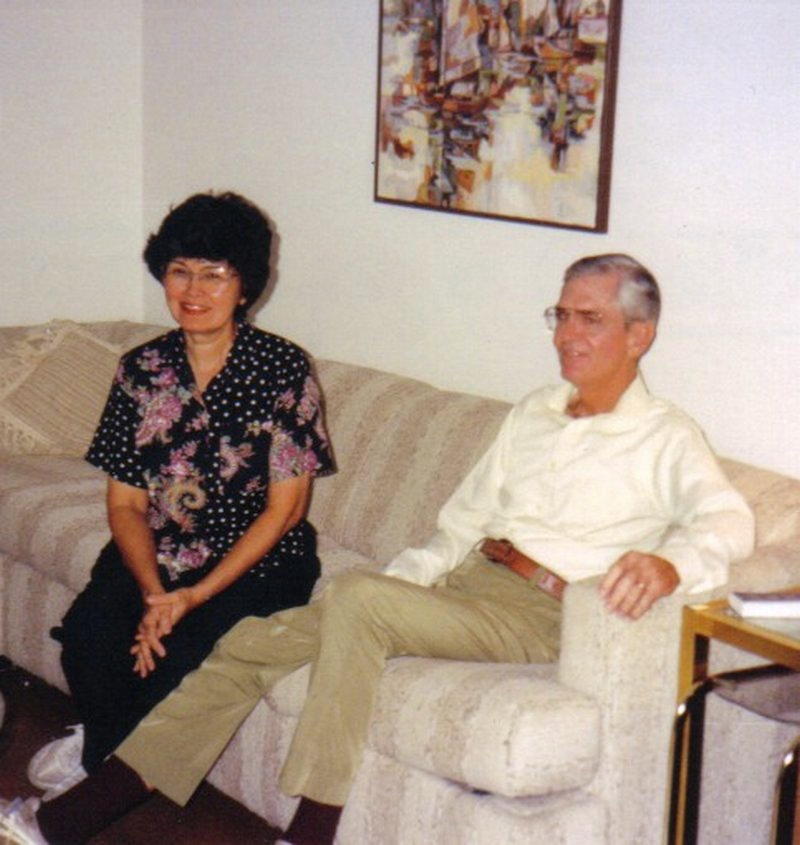 We
began attending the First Presbyterian Church of Homestead as soon as
we arrived, and soon got to know several families. Jack and Mary Polk
(see left) were particularly friendly to us, and Bob and Peggy
London as well. Jack was a pharmacist in a drug store he owned in
partnership, that had been founded by his father. Mary hailed from
Connecticut.
We
began attending the First Presbyterian Church of Homestead as soon as
we arrived, and soon got to know several families. Jack and Mary Polk
(see left) were particularly friendly to us, and Bob and Peggy
London as well. Jack was a pharmacist in a drug store he owned in
partnership, that had been founded by his father. Mary hailed from
Connecticut.
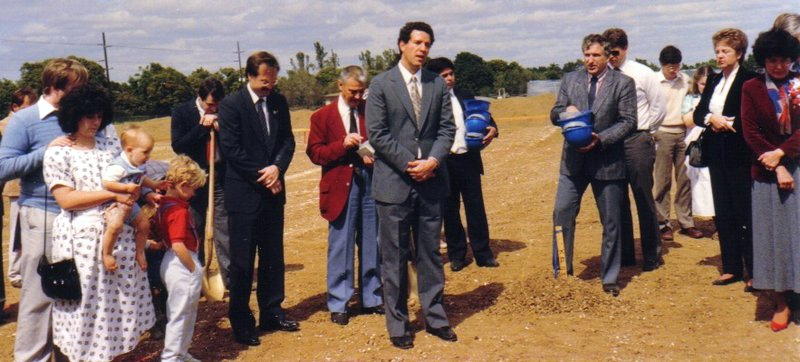
Bob
London was a retired mechanic from Eastern Air Lines. (In the picture
to the right, Bob is standing immediately behind and left of John
Leonard, center. This is the only picture I have that shows him.)
Peggy London was a retired school teacher (see below, right).
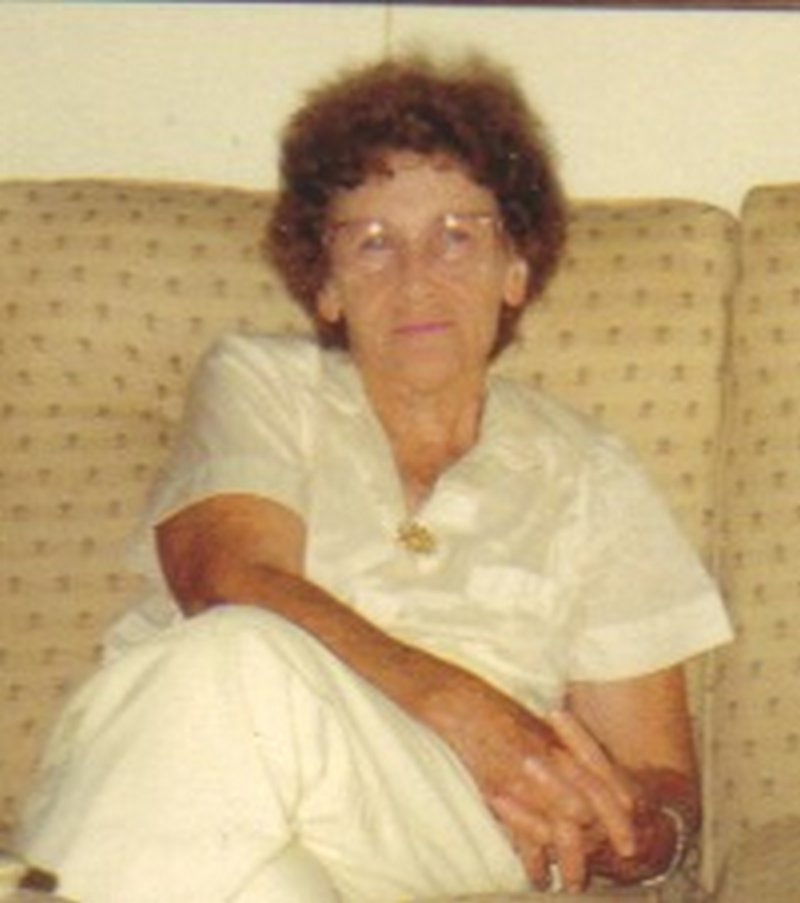
The
Londons had a 10-acre lime orchard which they worked largely by
themselves. Bob also had a tractor, and when he learned I wanted to
put up a fence on my south boundary, which abutted on six housing
development properties (being 610 feet long), offered to use his
tractor to dig the fence post holes and then to stretch the wire onto
the posts. That job took us nearly a week, but it was a good job, and
I believe the fence was still in good shape 11 years later, when we
sold it. The previous owner had sold off the southern 10 acres to the
developer who built the houses. This developer had bull-dozed the
southern half of the access road to our house, leaving only half a
lane. Try as I would, I could not find a contractor who would put in
a gravel drive for me — it was too small a job to warrant the
cost of bringing in the necessary machines. Finally, one said he
would do it, and dumped four truck loads of gravel and rock at the
far end of the drive. That was the last I saw of him — he just
wanted to get rid of that material! After six months, I had to spread
it myself, with pick, hoe and wheelbarrow, a job that took me six
weeks (not full time).
We Tour the US and Mexico
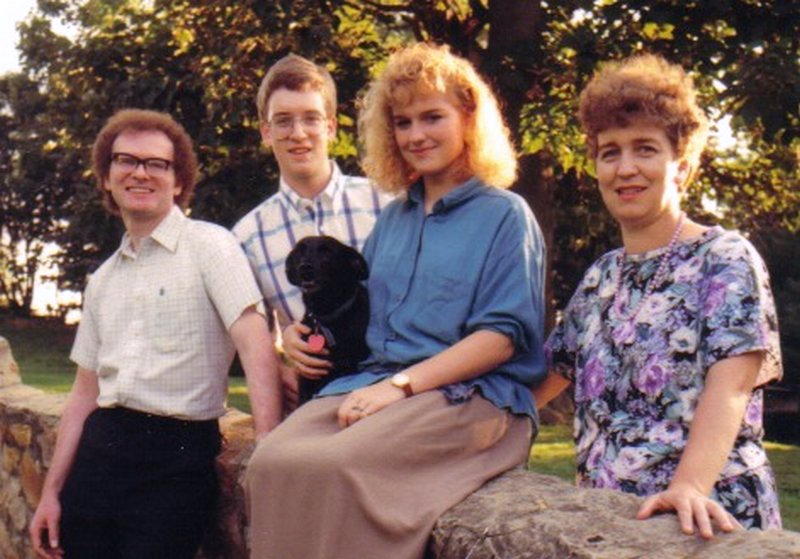 That
first summer (1979) we decided to revisit all our relatives and
friends across the United States in the Toyota, as well as take the
Eiki projector I had bought in Japan to Mr. Reyes in Cuernavaca. We
visited Mary Jo and Clyde in Birmingham (AL), Will, Judy, Mark and
Emily (see left) in Evansville, and Mary Francis and Bill
Spears in Denver. While in Denver, I had the opportunity at long last
to have a personal visit with Astronaut Jim Irwin, whose life and
ministry I had used as part of my speaking material during my
space-film evangelism years. From Denver we drove to Mexico City and
Cuernavaca to deliver the projector to Pastor Reyes, and then
returned to the US via the west coast of Mexico, which was new
territory for us.
That
first summer (1979) we decided to revisit all our relatives and
friends across the United States in the Toyota, as well as take the
Eiki projector I had bought in Japan to Mr. Reyes in Cuernavaca. We
visited Mary Jo and Clyde in Birmingham (AL), Will, Judy, Mark and
Emily (see left) in Evansville, and Mary Francis and Bill
Spears in Denver. While in Denver, I had the opportunity at long last
to have a personal visit with Astronaut Jim Irwin, whose life and
ministry I had used as part of my speaking material during my
space-film evangelism years. From Denver we drove to Mexico City and
Cuernavaca to deliver the projector to Pastor Reyes, and then
returned to the US via the west coast of Mexico, which was new
territory for us.
It was there that a tragedy occurred in poor
Su-Su’s demise in a motel in Guaymos, less than a day’s
journey from the US. It had been a very hot day, and Su-Su had been
very uncomfortable in the heat. We stopped at a dairy store and
bought some milk, giving Su-Su some off the top (probably nearly pure
cream). About eight o’clock she became distressed and tried to
vomit the milk, getting it caught in her throat. While Mary Charlotte
tried to help her, I went to the desk to try to get a vet, but the
only one in town didn’t answer his phone. When I got back Su-Su
had quieted and soon went to sleep. I woke up in the wee hours, with
a premonition that she was dead, and when I touched her, her body was
stiff. She must have died of a heart attack in her sleep. We left
some money with the motel attendant to bury her, and left, reaching
the border about noon. She was about eleven years old — a
fairly good age for a dog. If only this had happened in the good old
USA! Mary Charlotte didn’t show her grief, but she steadfastly
refused to get another dog ever since,and I am sure it is because she
doesn’t want to bear such a sorrow again.
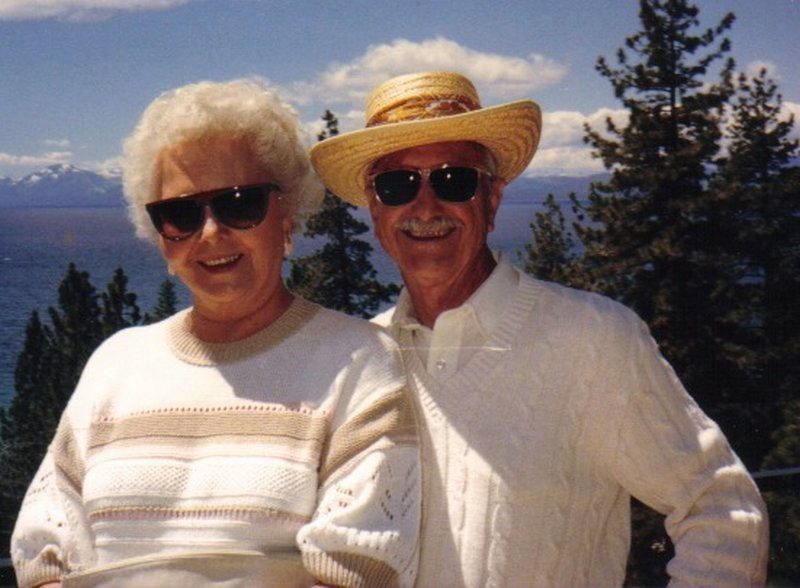

Not
having the dog made our subsequent visits much easier, as some of our
hosts were dubious about Su-Su. We visited the McCunes, the Conklins (see right),
and other friends in Los Angeles for several weeks, and then went up
the coast. Lance and Cora Bowen (see left) entertained us
royally, as is their wont, in Visalia (near Fresno), before we headed
for Washington State, where pleasant visits with the Romjues and the
Watsons awaited us. From thence we returned to Homestead, and I got
on with my renovations.
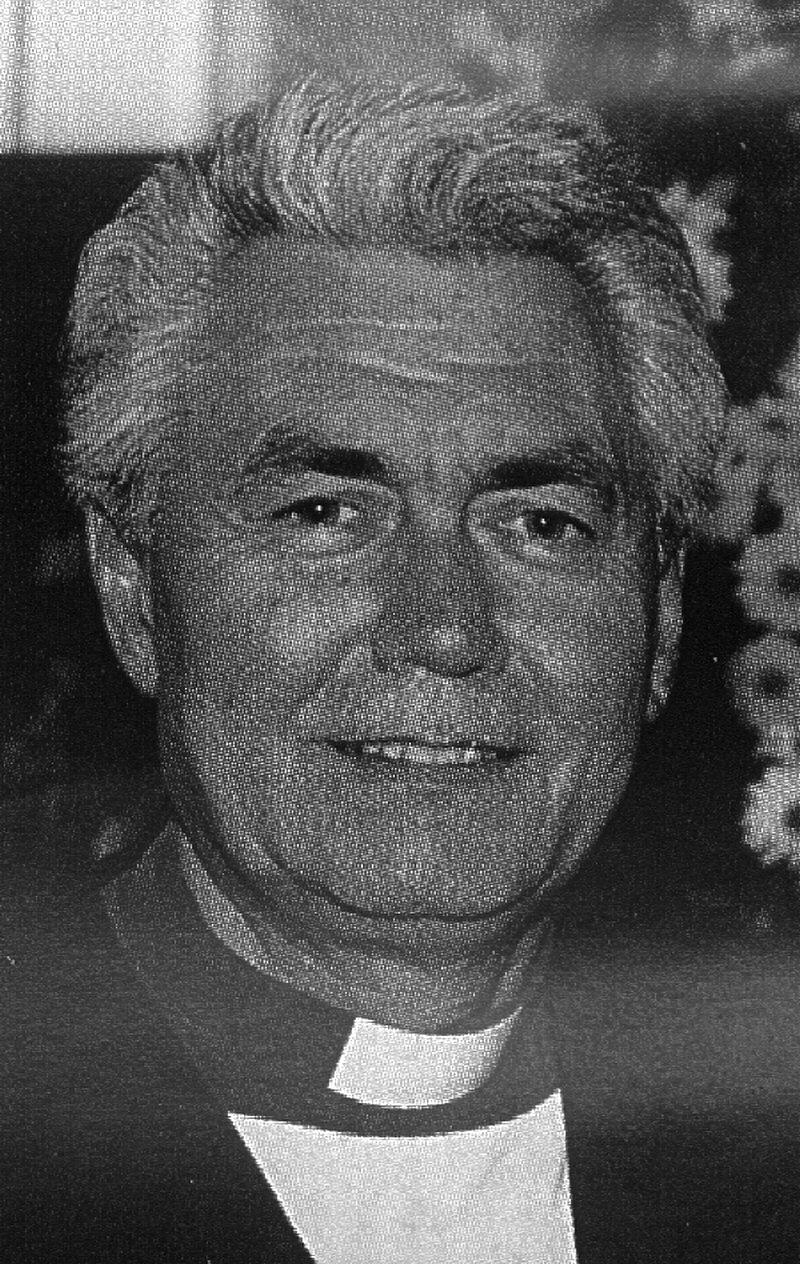
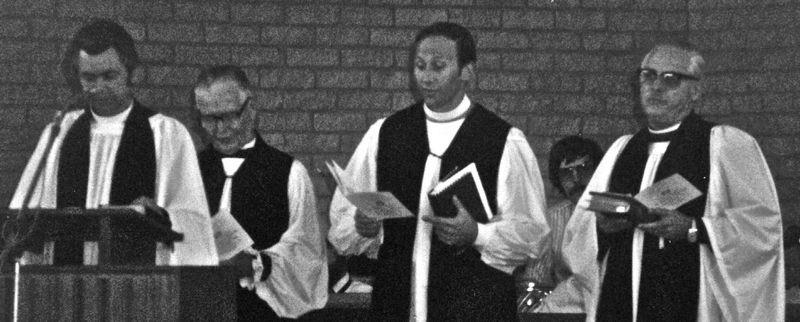 In
the latter part of 1979 we had a letter from Frank Retief (see
left) saying that he and Joe Bell (see right, from left to
right: Rector Frank Retief, Bishop Bradley, Bishop Joe Bell, and
Rector Murray Hofmyer) wih a church in Durban, would be coming
to the US and could visit us if we would like them to. We were
delighted to offer them our home and they arrived in February 1980.I
had arranged for our church to have Frank preach for us the Sunday he
was here, and for Joe Bell to preach in the Episcopal Church. I
didn’t know until that Sunday morning that our pastor was
opposed to giving Frank his pulpit, and actually called the
denomination office of the Episcopal Church in New York to inquire
about this “Church of England in South Africa” that Frank
represented. They told him that it was a splinter group, not
recognized by the Anglican body world-wide. He used that as a reason
we should not let him preach, but the session overruled Pastor Jim
Fleming, and Frank was on. I contacted the Episcopal Church and
verified that Joe Bell would be preaching there. We didn’t know
it at the time, but found out later that “Dr.” Jim
Fleming had bought his degree from a diploma mill in Homestead that
had never had a student. Frank’s sermon brought about the first
conversion in the church since we had been there. Bishop Bell was so
well received that many of the women actually cried over his
message.
In
the latter part of 1979 we had a letter from Frank Retief (see
left) saying that he and Joe Bell (see right, from left to
right: Rector Frank Retief, Bishop Bradley, Bishop Joe Bell, and
Rector Murray Hofmyer) wih a church in Durban, would be coming
to the US and could visit us if we would like them to. We were
delighted to offer them our home and they arrived in February 1980.I
had arranged for our church to have Frank preach for us the Sunday he
was here, and for Joe Bell to preach in the Episcopal Church. I
didn’t know until that Sunday morning that our pastor was
opposed to giving Frank his pulpit, and actually called the
denomination office of the Episcopal Church in New York to inquire
about this “Church of England in South Africa” that Frank
represented. They told him that it was a splinter group, not
recognized by the Anglican body world-wide. He used that as a reason
we should not let him preach, but the session overruled Pastor Jim
Fleming, and Frank was on. I contacted the Episcopal Church and
verified that Joe Bell would be preaching there. We didn’t know
it at the time, but found out later that “Dr.” Jim
Fleming had bought his degree from a diploma mill in Homestead that
had never had a student. Frank’s sermon brought about the first
conversion in the church since we had been there. Bishop Bell was so
well received that many of the women actually cried over his
message.
Just before they arrived the starter on the Toyota
went bad, and I had no chance to fix it. During the week I used Mary
Charlotte’s Plymouth (which I had given her for a present on
her last birthday) to take them around to see the sights, but she had
to have it on Friday for her hairdresser appointment. We wanted to
visit the Everglades so had to take the Toyota, which could only be
started by pushing (it had a manual transmission). When we were ready
to leave the visitor center at the park, Frank and Joe dutifully
pushed while I did the honors at the wheel. The Toyota wouldn’t
start. Finally a perspiring Bishop Joe Bell came up to me and asked,
“Have you turned on the key?” I hadn’t!
Within
a month after we arrived in Homestead, the church got an associate
pastor, Bill Davis, who was a real Christian and a fine preacher. As
associate he got to preach once a quarter! But he did lead Bible
study groups and other church activities and was a real blessing to
us. Through his leading we had a church renewal week-end that was a
tremendous blessing to the whole congregation. A layman named Bob
Fenn had started this work 20 years earlier in Texas, but was now
giving full time to it. He would bring a whole team to the church,
consisting of a preacher, an organist, a singer, and a number of lay
couples who had renewals in their churches. The program was a
concentrated one from Friday until Monday or later in the week, with
men’s and women’s luncheons, a sacred music concert,
men’s Bible study every morning, and preaching every night,
with “afterglow” meetings in local homes led by the
visiting couples. Three of the church’s younger wives came to
the Lord at one of the afterglow meetings, and for one of them it
meant the preservation of her marriage. Mary Charlotte and I acted as
such a couple at three renewals in later months, one in Marshall
(TX), one in Waynesboro (VA), and one in Clearwater (FL).
When
Frank and Joe were with us I asked them about the possibility of
using a computer to expedite the work of the church. Both of them
were mildly interested, but nothing definite came from the
discussion. Later in the year, however, Frank wrote to say that his
treasurer was quite keen on the idea. I decided I had enough of house
remodeling and Mary Charlotte had lost her enthusiasm for her “farm’,
so we were both ready for a change. I wrote and asked if they would
like me to donate a computer to the church and come over there for a
period of two years and show them how to use it. The answer was
strongly positive, but I felt I should make a visit to see for myself
if the “field was ripe” for such an enterprise. Also we
missed the close fellowship that we had enjoyed at St. James, which
we had not found in Homestead. So once again I began planning a trip.
We Return to South Africa for a Visit
Since Mary Charlotte had not gone to Argentina with me, I wanted her
to meet some of the people I had gotten to know and love there.
Argentine Air Lines offered an attractive round-trip excursion to
Cape Town, with a stopover in Buenos Aires, and that formed the basis
for our visit. The folks at Alfa y Omega were most cordial in wanting
us to visit, if only for the four days I suggested. I had the shock
of my life when we landed at the Buenos Aires airport, and changed
some money. Inflation had run wild in Argentina in the five years
since my last visit, so that now things were approximately 100 times
as expensive as then in Argentine pesos. But the rate of exchange had
increased only 14 times, the net effect of which was to make
everything seven times as expensive in dollars as it had been in
1975. A cab to the city would cost $50 for 15 miles, the bus $15. Our
second-rate hotel room was $60+ a night. Meals were $10-$20 for
simple food. I could see my budget shot down before ever reaching
South Africa! This situation came about due to the military take-over
of the government when I was there in 1975. In order to stimulate the
economy the government stopped just about all imports but continued
exports. The result was the building up of a huge surplus in their
foreign exchange — hence the poor exchange rate with the
dollar. This practice triggered a horrendous wave of inflation, as
the scarcity of commodities allowed the local manufacturers to ask
almost any price they wished. Finally, just before we arrived in
1980, the government threatened price control, to which the
manufacturers replied that they would shut down. The government
countered by lifting all import restrictions and consumer goods were
flooding the country. Argentines could fly to Miami or Cape town,
load up on appliances and other things, and return with their loot
for less Argentine money than to buy those items at home — and
they did, in large numbers — for a short while.
The Alfa
y Omega people were aware of our problem, and did their best to
provide us with meals and transportation, and got us the best hotel
rate they could find. They had arranged a few talks for me, but
allowed us time for sightseeing and visits. We had wonderful
fellowship with them, particularly Mike Mansfield. He had us to his
home twice in the four days, and took us to the airport when we left.
He told us of his very recent visit to England and his great
disappointment with the society there. It seems that the Chicago
Bridge Company had decided to pull out of Argentina and turn their
business over to their British associate, Mr. Mansfield being
included in the deal. He was invited to London to meet his new
management, and was overjoyed at the prospect of fulfilling a
lifelong ambition. His grandfather who came from England and his
father who had never gotten back had brought him up on tales of how
wonderful it was there, and of course taught him to speak perfect
English. However, when he got to London he found the society anything
but perfect! He said the clerks and salespeople were outrageously
rude. When he vent into a restaurant, every table would have at least
one person at it. If he joined a man, the man would approach him
homosexually; if he joined a woman, she would think he was
propositioning her. He was so bitter about it he could hardly get his
mind off the subject.
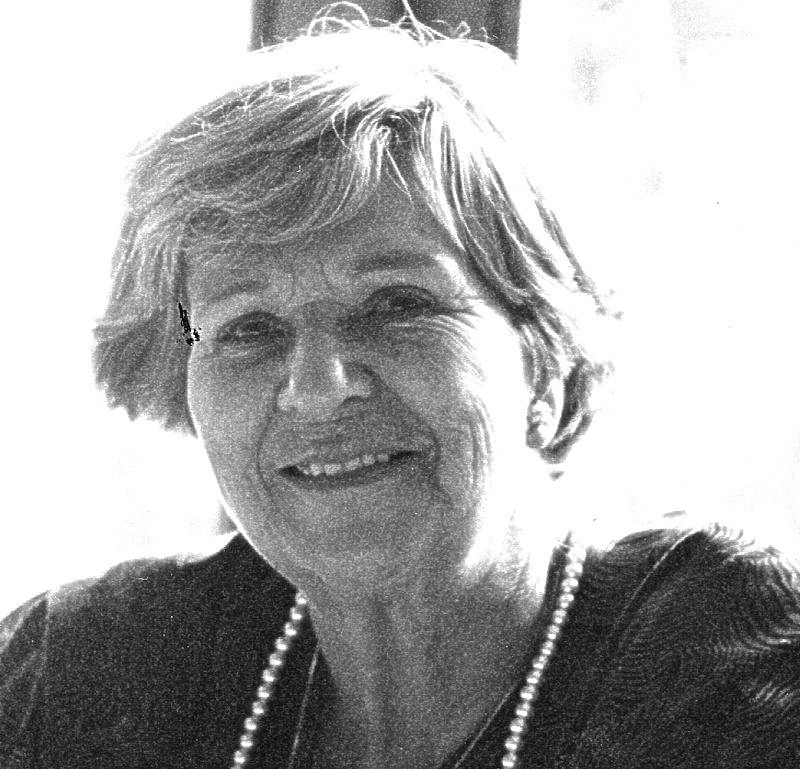 Our
friends in South Africa were very glad to see us, with a big
delegation meeting us at the airport. I had sessions with many of the
church leaders, particularly Frank Retief and Colin Holtman, the
treasurer. Drina Binedell (see left) offered us her apartment,
and stayed with Rhona while we were there. Frank Retief offered me
carte blanch in setting up my plans. I put together a proposal, much
as I would if it were a business deal, offering to provide the church
with a Wang computer and printer, with a motor-generator set to power
it; to donate two years of my time at the church to program the
computer and integrate it into the life of the church, teaching them
how to use it and continue its upkeep after I left. My only
compensation was to be provided accommodation for the two of us. This
was enthusiastically accepted, and I was invited to become a staff
member of the church to head the computer “department”.
After a round of dinner invitations from 15-20 of our closest
friends in the congregation (which we reciprocated by a dinner party
at the Mount Nelson Hotel, the best place to eat in Cape Town), we
completed the visit and returned home after the full six weeks the
airline permitted us on our bargain fare.
Our
friends in South Africa were very glad to see us, with a big
delegation meeting us at the airport. I had sessions with many of the
church leaders, particularly Frank Retief and Colin Holtman, the
treasurer. Drina Binedell (see left) offered us her apartment,
and stayed with Rhona while we were there. Frank Retief offered me
carte blanch in setting up my plans. I put together a proposal, much
as I would if it were a business deal, offering to provide the church
with a Wang computer and printer, with a motor-generator set to power
it; to donate two years of my time at the church to program the
computer and integrate it into the life of the church, teaching them
how to use it and continue its upkeep after I left. My only
compensation was to be provided accommodation for the two of us. This
was enthusiastically accepted, and I was invited to become a staff
member of the church to head the computer “department”.
After a round of dinner invitations from 15-20 of our closest
friends in the congregation (which we reciprocated by a dinner party
at the Mount Nelson Hotel, the best place to eat in Cape Town), we
completed the visit and returned home after the full six weeks the
airline permitted us on our bargain fare.
We Prepare to Return to Cape Town
We lost no time in preparing to
leave Homestead. We had set April 1st as the approximate time of
arriving in South Africa. I went to the Wang Company Miami office and
placed an order for a computer, which had a three-month backlog. I
had sold $12,000 of my Bunker-Ramo stock (which had doubled in value
just before I sold) in order to pay for the computer, but they only
wanted a 10% deposit. So I got a $10,000 US Treasury note for 90 days
at 16-3/4% interest!
When the note matured I found I had
enough extra money to buy a new model Xerox copier for the church. I
got everything crated up and arranged with the Mayflower (movers)
company to have it shipped. Incidentally, I was able to use their
sales tax exemption status for the computer, which saved enough to
pay the shipping costs! Bob London loaned me his pickup truck, and
the two of us got the crates to the Mayflower warehouse. We had
become friends with Stan Huie at the church. Stan was a Pan Am flight
engineer, who moonlighted in real estate with his wife Marge. He
undertook to sell our home on Mowry Drive. Even though there were no
prospects at the time we left, the people who looked at it the
following day gave us a contract, which we negotiated from Cape Town.
Two More Years in Cape Town
The church had rented a flat for us in a nearby building, but it was
on the third floor — walk-up. They had scrounged furniture from
goodness knows where, including a broken-down bed. On the third
night, I got up to find Mary Charlotte lying on the floor, as she
said that was more comfortable there than in the bed! The very next
day we bought a bed. Since Mary Charlotte couldn’t walk up so
many stairs, I asked Frank to get us a flat on the first floor, which
they were able to do after the first month. When we moved to our new
flat on a Saturday morning, 20-30 of the church men turned out, and
carried our things right down the middle of the street to the new
flat, with a pickup truck full of the heavier items following. A dear
old lady had bequeathed to the church an old but quite serviceable
Mercedes Benz, which none of the church staff dared to drive, so it
became our car. A garage of one of the houses owned by the church was
made into a computer center, and I spent several weeks getting the
two motor-generator sets installed, one for the computer and one for
the copier. George van der Westhuizen, who was a technical sergeant
in the military, helped me with this — or rather I helped him.
He later gave up his military career, went to seminary and later
pastored a mission church in a city in Namibia. He was one of the
four I had the privilege of assisting through seminary.
The
church had grown by leaps and bounds since we left, and was bursting
at the seams. The registration system I had inaugurated was still in
use, and the solid growth revealed by it justified a new sanctuary.
Plans had been made and a contract let to build a 1,000-seater,
starting in a few months. Ground was broken within a month of our
arrival.
One of the weaknesses of most pastors is their lack
of training in (and in most cases interest in) administration. Frank
Retief was no exception. As rector, he ran everything. The church
council was just that — advisory only. Frank could overrule its
recommendations, and occasionally did. It was painfully evident to me
that the church needed a business manager, particularly as it
undertook this large construction project. Fortunately for Frank,
Murray Hofmeyr (see picture above right of four clergymen in CESA,
he is the man at the far right), the man at whose home we had
stayed when we first arrived in Cape Town, had just retired and
offered to supervise the building contract, the very thing he had
been doing most of his life on much larger construction jobs. But
there was no one to take care of the myriad details of getting the
church geared up for a much larger congregation. I volunteered to act
as business manager — fools rush in... The council and Frank
were delighted and told me to write up a job description, which I
did, using best US practice. This was unanimously accepted, and the
job was mine. Our treasurer had been very slow in paying our bills,
partly because the people who incurred them didn’t validate the
receipt of the equipment or services. Two or three firms had shut off
our credit, and several others were demanding payment. So the first
thing I did was to get our bills paid up. Then it was decided to
repaint the older buildings of the church plant, groom the grounds,
and bring everything up to the standard the new building would set. I
set up volunteer groups and established job descriptions — but
then I made the discovery that you can lead a horse to water...!
Those people didn’t pay any attention to me, Frank included.
They continued to do things the way they had always done them —
not the much better way I was prescribing. One thing led to another,
until I was at my wits end. Then I committed a no-no. I raised my
voice in a board meeting! You might have thought I had raped the
pastor’s wife.
Ihere was nothing left for me to do but
to retreat into my computer center, and let the church flounder on,
and I soon had my hands full with my new programs. My major program
was one which monitored the comings and goings of the people to the
various services (with the plan of extending the monitoring to all
activities in the church). My aim was to get the new program going in
time to monitor the new sanctuary meetings from their beginning. My
diversion into church management had the further consequence of
putting me behind in my checkout of this complex program, and there
were still some serious bugs left when the great day arrived.
Nevertheless, I started up then and kept it going for the rest of my
stay. Even though I cleaned up the bugs, the corruption to the data
base introduced by them caused it to gradually deteriorate until it
had to be abandoned shortly after I left. We recorded the names and
addresses of every person who attended each of the three services on
Sunday and the main midweek meeting on Wednesday from the “yellow
pads" placed in every pew.
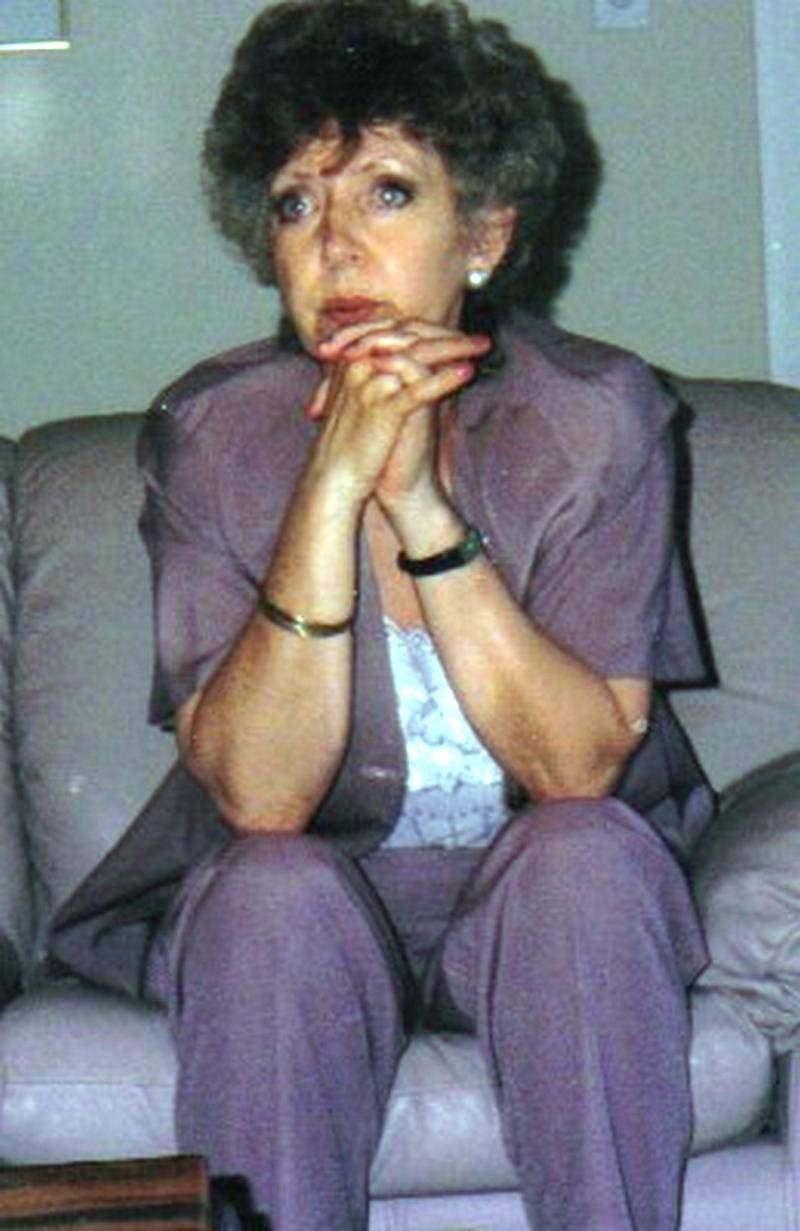 I
soon had to get help here, and hired (at my expense) a beautiful lady
named Julie Labuschagne (see left), one of the hardworking
church ladies. She did this typing every week until I left at the end
of our two years, and did it very well. The pastors (there were three
by now) became quite enthusiastic about the data I was providing, but
it took a while for them to appreciate it.
I
soon had to get help here, and hired (at my expense) a beautiful lady
named Julie Labuschagne (see left), one of the hardworking
church ladies. She did this typing every week until I left at the end
of our two years, and did it very well. The pastors (there were three
by now) became quite enthusiastic about the data I was providing, but
it took a while for them to appreciate it.
I had designed and
programmed (but not checked out) an accounting system for the church,
based on my experience as business manager, but wasn’t able to
get the church treasurer, a professional accountant, to buy it. I
suppose I deviated too far from the practices he was used to.
The
popularity of the new church building became phenomenal. It was the
largest evangelical church building in the Cape area, and became the
center for many city-wide Christian meetings. There was a steady
stream of visitors from all over the country. My record of the first
calendar year showed that over 7,000 people attended one service and
never came back. The church has continued to grow until in 1990 there
were five services a Sunday, and plans are well along to double the
size of the sanctuary (since accomplished). Frank Retief has become
one of the leading evangelicals in the country, and is the favorite
choice of the government TV management to provide the evening
sign-off "benediction”. It has never ceased to amaze both
Mary Charlotte and me how the Lord has used that body of believers,
who numbered only 250 when we first became a part, but who now are
more than 2,000, with nearly 30 daughter churches and preaching
points. This one church has supplied over half of all the new pastors
for the denomination, and now supports three missionary families.
There are over 25 women’s groups, plus 15-20 organizations for
families, couples and singles. The Sunday School reaches over 1,000
kids, with a mission Sunday School in a black community of 250. We
consider it one of the greatest privileges of our lives to have been
a part of the development of this part of God’s kingdom on
earth!
About seven months before my 2-year commitment was up,
I wrote a long letter to Frank Retief and the church council setting
down the steps I recommended for them to take to keep the computer
services functioning after my departure. The primary need was for a
replacement for me. I urged that such person be procured as soon as
possible so that I could train him or her in the details of the
programs I had written. This floored them. Frank asked me to find
such a person, but I said it was beyond my capabilities. By the end
of the year, Frank had decided to take on the staff a young man named
Peter Gird who was just graduating from Bible Institute. Frank
thought that since he had worked in a computer environment before
attending seminary he would be ideal for the job. When Peter came on
staff I learned from him that he knew nothing about computers and had
no interest in learning. This was now January and we were leaving
April 2nd, replacement or no. In February, Frank invited Janneke
Grazioli, a woman in the church who had been a programmer but was now
a doctor’s wife with a very energetic 2-year-old boy. She
agreed to take over the work, so I went to her flat on many occasions
to teach her the programs. We were limited to the time her son took
his nap, as after he woke it took her full time to keep him from
wrecking the place.
About a year before this I had gone with
Frank to one of the daughter churches, where a missionary on
furlough, Jim Nesbitt, was serving as pastor. Jim was with the
Overseas Missionary Fellowship, and had been serving as the mission
accountant and business manager for the Japan-Korean field of OMF.
Subsequent to my meeting him he took a two-year assignment as
Director of Finance for the Mission at its headquarters in Singapore.
I wrote to him and asked him if OMF was considering computerizing,
and if so would he be interested in my services as a consultant. He
wrote back with strong affirmatives for both questions, and it was
arranged that I would start July 1st, after visiting the headquarters
in Singapore on my way back to the US from South Africa.
Interestingly enough, Jim’s replacement as Japan “secretary”
was a friend from St. James, Roger Williams. We had become quite fond
of him and his wife Denise. Since we could easily pass through Tokyo
on our way to the US from Singapore, we decided to visit the
Williams’ in Sapporo (the northern city where OMF had its Japan
HQ). Our air tickets were horrendously expensive, particularly the
portion from South Africa to Singapore, because there was only one
flight a week available without going back to Europe, and British
Airways charged the same fare as if we did go back to
Europe.
Finally the day came when we were to leave, and we had
even a bigger send-off this time than the one in 1978. We were
supposed to take the early flight for Jo’burg in order to take
the BA flight out of there at 11am. When we arrived there, we were
told that the BA plane was still in Hong Kong! We finally left at 5am
the next morning, missing our connection in Columbo, and arriving in
Singapore a day late. We had two weeks there, living in the
dormitories for missionaries attending orientation classes, and I had
interviews with all the directors, including Dr. James Hudson Taylor
III, great-grandson of the founder of the mission. Jim Nesbitt had
already bought himself one of the very early desktop machines, and
was learning how to use it — a very good sign to me. But I soon
found out that computing with these small machines was a different
ball game from the computing I knew, and that I was in for some major
updating of my computer skills before I could hope to do anything for
OMF. From Singapore we went to Sapporo, and had a very pleasant week
with Roger and Denise Williams.
 While
there, we visited Glenda King, a mission schoo1 teacher from St.
James, who later married one of Mary Charlotte’s favorite young
men at St. James, Rod Thomas. They had a courtship strictly by
correspondence, although they had casually met while attending St.
James Church in Cape Town. Although this is my conjecture, I believe
they were led to consider marriage primarily because both wanted to
be be missionaries in Japan. The effectiveness of their marriage is
evident from this picture. Their family is even larger now.
While
there, we visited Glenda King, a mission schoo1 teacher from St.
James, who later married one of Mary Charlotte’s favorite young
men at St. James, Rod Thomas. They had a courtship strictly by
correspondence, although they had casually met while attending St.
James Church in Cape Town. Although this is my conjecture, I believe
they were led to consider marriage primarily because both wanted to
be be missionaries in Japan. The effectiveness of their marriage is
evident from this picture. Their family is even larger now.
We
got back to Homestead about the middle of May, and lived with Stan
and Marge Huie, until we could move into the house which they found
for us at 17381 SW 302 Street on our 47th wedding anniversary, June
20, 1983.
Go to next
chapter
Return to Table of
Contents
 That
first summer (1979) we decided to revisit all our relatives and
friends across the United States in the Toyota, as well as take the
Eiki projector I had bought in Japan to Mr. Reyes in Cuernavaca. We
visited Mary Jo and Clyde in Birmingham (AL), Will, Judy, Mark and
Emily (see left) in Evansville, and Mary Francis and Bill
Spears in Denver. While in Denver, I had the opportunity at long last
to have a personal visit with Astronaut Jim Irwin, whose life and
ministry I had used as part of my speaking material during my
space-film evangelism years. From Denver we drove to Mexico City and
Cuernavaca to deliver the projector to Pastor Reyes, and then
returned to the US via the west coast of Mexico, which was new
territory for us.
That
first summer (1979) we decided to revisit all our relatives and
friends across the United States in the Toyota, as well as take the
Eiki projector I had bought in Japan to Mr. Reyes in Cuernavaca. We
visited Mary Jo and Clyde in Birmingham (AL), Will, Judy, Mark and
Emily (see left) in Evansville, and Mary Francis and Bill
Spears in Denver. While in Denver, I had the opportunity at long last
to have a personal visit with Astronaut Jim Irwin, whose life and
ministry I had used as part of my speaking material during my
space-film evangelism years. From Denver we drove to Mexico City and
Cuernavaca to deliver the projector to Pastor Reyes, and then
returned to the US via the west coast of Mexico, which was new
territory for us.


 In
the latter part of 1979 we had a letter from Frank Retief (see
left) saying that he and Joe Bell (see right, from left to
right: Rector Frank Retief, Bishop Bradley, Bishop Joe Bell, and
Rector Murray Hofmyer) wih a church in Durban, would be coming
to the US and could visit us if we would like them to. We were
delighted to offer them our home and they arrived in February 1980.I
had arranged for our church to have Frank preach for us the Sunday he
was here, and for Joe Bell to preach in the Episcopal Church. I
didn’t know until that Sunday morning that our pastor was
opposed to giving Frank his pulpit, and actually called the
denomination office of the Episcopal Church in New York to inquire
about this “Church of England in South Africa” that Frank
represented. They told him that it was a splinter group, not
recognized by the Anglican body world-wide. He used that as a reason
we should not let him preach, but the session overruled Pastor Jim
Fleming, and Frank was on. I contacted the Episcopal Church and
verified that Joe Bell would be preaching there. We didn’t know
it at the time, but found out later that “Dr.” Jim
Fleming had bought his degree from a diploma mill in Homestead that
had never had a student. Frank’s sermon brought about the first
conversion in the church since we had been there. Bishop Bell was so
well received that many of the women actually cried over his
message.
In
the latter part of 1979 we had a letter from Frank Retief (see
left) saying that he and Joe Bell (see right, from left to
right: Rector Frank Retief, Bishop Bradley, Bishop Joe Bell, and
Rector Murray Hofmyer) wih a church in Durban, would be coming
to the US and could visit us if we would like them to. We were
delighted to offer them our home and they arrived in February 1980.I
had arranged for our church to have Frank preach for us the Sunday he
was here, and for Joe Bell to preach in the Episcopal Church. I
didn’t know until that Sunday morning that our pastor was
opposed to giving Frank his pulpit, and actually called the
denomination office of the Episcopal Church in New York to inquire
about this “Church of England in South Africa” that Frank
represented. They told him that it was a splinter group, not
recognized by the Anglican body world-wide. He used that as a reason
we should not let him preach, but the session overruled Pastor Jim
Fleming, and Frank was on. I contacted the Episcopal Church and
verified that Joe Bell would be preaching there. We didn’t know
it at the time, but found out later that “Dr.” Jim
Fleming had bought his degree from a diploma mill in Homestead that
had never had a student. Frank’s sermon brought about the first
conversion in the church since we had been there. Bishop Bell was so
well received that many of the women actually cried over his
message. So
right after Christmas we took off for Homestead, stopping in
Birmingham, where Mary Jo and Clyde now lived, to spend a few days.
The morning we were to leave was bitterly cold and the van wou1dn‘t
start. A new battery from Sears fixed that, and we were off, getting
to Homestead late that day. We had rented a duplex in the not-so-good
part of town, which had a number of Mexican migrant laborers living
in the other unit. they helped me unload the van into one of the
rooms. Again the van wouldn’t start, and we had left the Toyota
with Will. I walked all over town (about eight miles), buying a
bicycle that I had to wait until the next day to have assembled,
starting a bank account and buying groceries. One of the Mexicans was
a back-yard mechanic and he said the points were bad. I mounted my
bicycle and bought new points, which he installed. That did it! We
lost no time in returning to Anderson to retrieve our Toyota and come
back to our new home.
So
right after Christmas we took off for Homestead, stopping in
Birmingham, where Mary Jo and Clyde now lived, to spend a few days.
The morning we were to leave was bitterly cold and the van wou1dn‘t
start. A new battery from Sears fixed that, and we were off, getting
to Homestead late that day. We had rented a duplex in the not-so-good
part of town, which had a number of Mexican migrant laborers living
in the other unit. they helped me unload the van into one of the
rooms. Again the van wouldn’t start, and we had left the Toyota
with Will. I walked all over town (about eight miles), buying a
bicycle that I had to wait until the next day to have assembled,
starting a bank account and buying groceries. One of the Mexicans was
a back-yard mechanic and he said the points were bad. I mounted my
bicycle and bought new points, which he installed. That did it! We
lost no time in returning to Anderson to retrieve our Toyota and come
back to our new home. We
began attending the First Presbyterian Church of Homestead as soon as
we arrived, and soon got to know several families. Jack and Mary Polk
(see left) were particularly friendly to us, and Bob and Peggy
London as well. Jack was a pharmacist in a drug store he owned in
partnership, that had been founded by his father. Mary hailed from
Connecticut.
We
began attending the First Presbyterian Church of Homestead as soon as
we arrived, and soon got to know several families. Jack and Mary Polk
(see left) were particularly friendly to us, and Bob and Peggy
London as well. Jack was a pharmacist in a drug store he owned in
partnership, that had been founded by his father. Mary hailed from
Connecticut.


 Our
friends in South Africa were very glad to see us, with a big
delegation meeting us at the airport. I had sessions with many of the
church leaders, particularly Frank Retief and Colin Holtman, the
treasurer. Drina Binedell (see left) offered us her apartment,
and stayed with Rhona while we were there. Frank Retief offered me
carte blanch in setting up my plans. I put together a proposal, much
as I would if it were a business deal, offering to provide the church
with a Wang computer and printer, with a motor-generator set to power
it; to donate two years of my time at the church to program the
computer and integrate it into the life of the church, teaching them
how to use it and continue its upkeep after I left. My only
compensation was to be provided accommodation for the two of us. This
was enthusiastically accepted, and I was invited to become a staff
member of the church to head the computer “department”.
After a round of dinner invitations from 15-20 of our closest
friends in the congregation (which we reciprocated by a dinner party
at the Mount Nelson Hotel, the best place to eat in Cape Town), we
completed the visit and returned home after the full six weeks the
airline permitted us on our bargain fare.
Our
friends in South Africa were very glad to see us, with a big
delegation meeting us at the airport. I had sessions with many of the
church leaders, particularly Frank Retief and Colin Holtman, the
treasurer. Drina Binedell (see left) offered us her apartment,
and stayed with Rhona while we were there. Frank Retief offered me
carte blanch in setting up my plans. I put together a proposal, much
as I would if it were a business deal, offering to provide the church
with a Wang computer and printer, with a motor-generator set to power
it; to donate two years of my time at the church to program the
computer and integrate it into the life of the church, teaching them
how to use it and continue its upkeep after I left. My only
compensation was to be provided accommodation for the two of us. This
was enthusiastically accepted, and I was invited to become a staff
member of the church to head the computer “department”.
After a round of dinner invitations from 15-20 of our closest
friends in the congregation (which we reciprocated by a dinner party
at the Mount Nelson Hotel, the best place to eat in Cape Town), we
completed the visit and returned home after the full six weeks the
airline permitted us on our bargain fare.
 I
soon had to get help here, and hired (at my expense) a beautiful lady
named Julie Labuschagne (see left), one of the hardworking
church ladies. She did this typing every week until I left at the end
of our two years, and did it very well. The pastors (there were three
by now) became quite enthusiastic about the data I was providing, but
it took a while for them to appreciate it.
I
soon had to get help here, and hired (at my expense) a beautiful lady
named Julie Labuschagne (see left), one of the hardworking
church ladies. She did this typing every week until I left at the end
of our two years, and did it very well. The pastors (there were three
by now) became quite enthusiastic about the data I was providing, but
it took a while for them to appreciate it. While
there, we visited Glenda King, a mission schoo1 teacher from St.
James, who later married one of Mary Charlotte’s favorite young
men at St. James, Rod Thomas. They had a courtship strictly by
correspondence, although they had casually met while attending St.
James Church in Cape Town. Although this is my conjecture, I believe
they were led to consider marriage primarily because both wanted to
be be missionaries in Japan. The effectiveness of their marriage is
evident from this picture. Their family is even larger now.
While
there, we visited Glenda King, a mission schoo1 teacher from St.
James, who later married one of Mary Charlotte’s favorite young
men at St. James, Rod Thomas. They had a courtship strictly by
correspondence, although they had casually met while attending St.
James Church in Cape Town. Although this is my conjecture, I believe
they were led to consider marriage primarily because both wanted to
be be missionaries in Japan. The effectiveness of their marriage is
evident from this picture. Their family is even larger now.